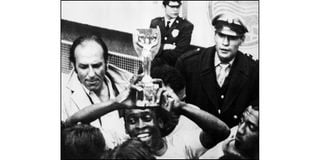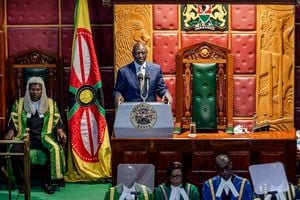Chaotic two-week journey by ship to first World Cup

In this file photo taken on June 21, 1970 Brazilian forward Pelé smiles as he holds aloft the Jules Rimet Cup after Brazil beat Italy 4-1 in the World Cup final in Mexico City.
What you need to know:
- For the next few days from today, in the build-up to the Fifa World Cup, we exclusively run excerpts from Fifa World Cup — A History of the Planet’s Biggest Sporting Event, a new book by US-based veteran football reporter, Clemente A. Lisi
- US-based Lisi chronicles the tournament from 1930 to today, including a preview of this month’s World Cup in Qatar, providing vivid accounts of individual games, details the innovations that impacted the sport across the decades, and offers biographical sketches of greats such as Pelé, Diego Maradona, and Lionel Messi
The 1930 World Cup: The very first World Cup began with a two-week journey across the Atlantic Ocean to Montevideo.
The SS Conte Verde left the Italian port city of Genoa on June 21, 1930, headed to South America with Romania’s national soccer team.
The Italian steamboat stopped at Ville-franche-sur-Mer, where they picked up the French team, three referees, and a group of dignitaries, including Fifa president Jules Rimet, who packed the shiny, gold World Cup trophy in his suitcase.
The creation of French sculptor Abel Lafleur, Rimet noted in his journal that “the gold of the trophy is symbolic for the World Cup becoming the world’s greatest sports event.”
The ship made stops in Barcelona, where they were joined by the Belgians, and then picked up the Brazilian team in Rio do Janeiro on June 29 before arriving for its final stop in the Uruguayan capital five days later.
Three-day train trip
Rimet noted that there was no shortage of distractions on board during the transatlantic voyage.
“One can use the swimming pool, the fitness room, and the library,” Rimet recalled in his diary.
“In the evening after dinner—that is by itself a distraction—passengers have to choose between the ballroom, cinema, and live comedy shows.”
Only Yugoslavia failed to join them because the Conte Verde was fully booked. Instead, they took a three-day train trip to Marseille in order to board the cruise liner Florida.
Egypt, the only African team at the World Cup, had been scheduled to join them, but their boat from Africa was delayed by a storm.
As a result, the Florida left without them. Instead, they sent a cable apologizing for their absence.
At the same time, the Mexicans sailed from Veracruz to Hoboken, near New York City, so they could join the Americans on the SS Munargo.
Players on the three boats spent the journey training on the deck—jogging, stretching, lifting weights, and even running up and down the ship’s narrow stairs to stay fit.
For Rimet, a Frenchman, the trip to the first-ever World Cup had been decades in the making. Rimet had been involved in the founding of the Fédération Internationale de Football Association (commonly known as Fifa) in 1904.
Creating a competition open to professionals allowed the World Cup to be unique, distinguishing itself from the Olympics.
It had not been an easy road, but Rimet was used to adversity.
Born in the eastern French town of Haute-Saône in 1876, the first of five children, Rimet was the son of a grocer who moved the family to Paris when Jules was just 11.
Rimet, a fencer and runner in his youth, was not a very good soccer player. He became a lawyer and at age 24 started a soccer team called Red Star. The club—now known as Red Star Saint-Ouen—is one of France’s oldest.Although he had political ambitions, Rimet would never be elected to public office. Instead, he would prove to be a visionary leader for a sport that would become global within decades.
In 1910, Rimet was instrumental in the creation of France’s Football Association League, the country’s first national soccer competition, and was named its first president. By 1919, the league’s foundation led to the formation of the French Football Federation, which exists to this day. Rimet’s work in France led to his election as Fifa’s president in 1921.
Rimet had been shocked by the horrors of World War I.
Expulsion of Germany
A global tournament for nations could be a uniting force, Rimet argued. When the war ended, Fifa’s members proved they were not immune to conflict themselves when some members called for the expulsion of Germany and the nations from the Central Powers, though they were in the minority.
The major issue at the time, however, was the definition of what constituted an amateur athlete. This was crucial for determining who could or couldn’t play at the Olympics. Could a player be financially compensated to play for his country in the World Cup and still be considered an amateur?
An astute administrator, Rimet was in for an uphill fight when it came to creating the World Cup. Since the start, Fifa had been looking for a way to host an international tournament featuring national teams. Rimet always had plans for a global professional tournament. World War I had put those plans on hold. It was at the 1920 Summer Olympics in Antwerp that Rimet first made a strong push for the World Cup’s creation.
Rimet’s plan for an international tournament featuring pros, while also unifying the world through sport, was met with opposition. Rimet and fellow soccer administrator Henri Delaunay persevered in their efforts.
By 1926, both men were convinced a World Cup needed to happen. “International football can no longer be held within the confines of the Olympics, and many countries where professionalism is now recognized and organized cannot any longer be represented there by their best players,” Delaunay told the Fifa Congress in 1926.
Four years later, Fifa — by a vote of 25 to 10 — approved the creation of a World Cup tournament that would be held every four years. The vote would forever transform the sports world.
Tomorrow: Why and how the first World Cup was hosted in Uruguay





